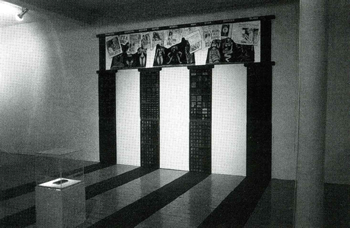“SHOEMAKER'S DAUGHTER” 1988

POPULAR PRESS While it is a shock to see the minuscule dimensions of a slipper made for the three inch foot of a Chinese noblewoman, foot binding nevertheless seems too archaic a symbol of female bondage to reflect the subtler forms of repression alive today.
Juxtaposed with the slippers is an image from a newspaper story of an eleven-year-old Asian girl busy at a sewing machine stitching shoes for her father's business. The implications of importing to Britain of third world customs like child labour or the imposition of purdah and the veil are far more pertinent than foot binding, and it's odd that Garrard focuses more on historical than the contemporary exploitation.
Sarah Kent, Time Out, November 23 1988
ARTIST'S NOTES Subtle and not so subtle forms of child labour have a long colonial tradition both here and abroad, and since the recession, are on the increase again in the poorest communities of Britain, regardless of their racial origin. The newspaper article about an Asian child working for her father in one of the many local East End sweat shops, stated she was actually making stiletto heeled ladies shoes. At its simplest. I was concerned in the piece to present a number of threads connecting the contemporary issues raised by this report, to the history of women and girl-children suffering in order to please men. There seems to me to be an obvious and direct parallel between 20th century western women wearing stilettos to feel attractive and 19th century eastern women wanting their feet bound for the same reason, the only change being that the power of the royal court to determine high fashion has been superseded by the power of the contemporary media.
The title 'Shoemaker's Daughter' implies this patriarchal inheritance, and is reinforced by the central presentation of a Victorian book 'How to Please'. The main images in the exhibition portray not only the child labour of the daughter in the current newspaper article, but other press images and texts which seek to disempower the independent roles which women do occupy today. These are shown literally covering over ancient female figures from allover the world, who represented these roles in a positive way within their cultures. Four embroidered women's shoes from a variety of continents and times were presented in small glass cases, the oldest of which was the tiny footbound shoe worn by an adult Chinese woman just over one hundred years ago. In this way the exhibition indicated the world-wide continuity of these systems of repression from the past to the present.
'Men took from you your ability to walk?' the Lord said incredulously, 'Is it the man who pulls the binding cloth to cripple a daughter's feet? No man could do a thing like that. No man could bear it.
'No man would marry a natural-footed woman. There is more to binding feet than just the binding! ... Lady Guo Guo shook with fury and called after him.'
Rose Garrard 1994
(Text from 'A Visit from the Footbinder' by Emily Prager, Hogarth Press 1983)
SITE
'Shoemaker's Daughter' Air Gallery London
COMPONENTS
Two long painted canvas panels facing each other on opposite walls, . supported by columns made of printers' block trays, linked by four felt strips. Four plinths and perspex cases each containing an embroidered shoe from various cultures. A fifth case containing a Victorian treatise entitled 'How to Please'.